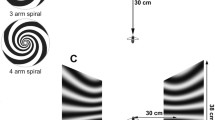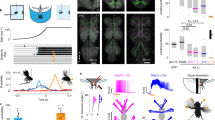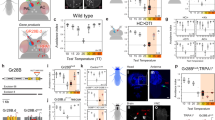Abstract
The landing response ofDrosophila can easily be elicited by visual stimuli. The response probability decreases with repeated stimulus presentation. The present paper shows that this habituation of the response occurs near to the level of the sensory input. The neurons habituating have relatively small receptive fields.
Access this chapter
Tax calculation will be finalised at checkout
Purchases are for personal use only
Preview
Unable to display preview. Download preview PDF.
Similar content being viewed by others
References
Bausenwein B, Wolf R and Heisenberg M (1986) Genetic Dissection of Optomotor Behavior in Drosophila melanogaster. Studies on Wildtype and the Mutantoptomotor-blind H31. J. Neurogenetics 3, 87–109
Borst A and Bahde S (1987) Comparison between the Movement Detection System Underlying the Optomotor and the Landing Response in the Housefly. Biol.Cybem. 56. 217–224
Buchner E (1976) Elementary movement detectors in an insect visual system. Biol. Cybernet. 24, 85–101.
Buchner E, Buchner S, Bülthoff I (1984) Deoxyglucose mapping of nervous activity induced in Drosophila brain by visual movement Part I. Wildtype. J.Comp.Physiol. (A) 155, 471–483
Buchner E, Götz K G, Straub C (1978) Elementary Movement Detectors for Vertical Movement in the Visual System of Drosophila. Biol. Cybern, 31, 235–242
Bülthoff I and Buchner E (1985) Deoxyglucose mapping of nervous activity induced in Drosophila brain by visual movement. II. optomotor blind H31 and lobulaplate-less N684, visual mutants. J. Comp. Physiol (A) 156, 25–34
Campos-Ortega, J and Strausfeld, N J (1972) Columns and layers in the second synaptic region of the fly’s visual system. The case for two superimposed neuronal architectures. In Information processing in the visual system of arthropods. Ed. R Wehner. Springer Verlag. Berlin
Duerr J S and Quinn W G (1982) Three Drosophila mutations that block associative learning also affect habituation and sensitization. Proc.Natl.Acad.Sci. USA 79, 3646–3650
Eriksson E S (1984) Vector analysis in a neural network. J. Insect Physiol. 30, 363–368
Fischbach K F (1981) Habituation and sensitization of the landing response of Drosophila melanogaster. Naturwissenschaften 68, 332
Fischbach, KF (1983) Neurogenetic am Beispiel des visuellen Systems von Drosophila melanogaster.Habilitation Thesis, Würzburg
Fischbach, K F and Heisenberg, M (1984) Neurogenetics and Behaviour in Insects. J. Exp.Biol. 112, 65–93
Götz K G and Wenking H (1973) Visual control of locomotion in the walking fruitfly Drosophila. J. Comp. Physiol. 85, 235–266
Hausen K (1984) The Lobula Complex of the Fly: Structure, Function and Significance in Visual Behaviour, in: Photoreception and Vision in Invertebrates Ed. MA Ali Plenum,New York
Heisenberg M and Buchner E (1977) The role of retinula cell types in visual behavior of Drosophila melanogaster. J. Comp. Physiol. 117, 127–162
Heisenberg M and Wolf R (1984) Vision in Drosophila. Springer Verlag Berlin
Heisenberg M, Wonneberger R, and Wolf R (1978) Optomotorblind H31 - a Drosophila mutant of the lobula plate giant neurons. J. Comp. Physiol. 124, 287–296
Hengstenberg R (1982) Common Visual Response Properties of Giant Vertical Cells in the Lobula Plate of the BlowflyCalliphora. J. Comp.Physiol. (A) 149, 179–193
Jakob K G, Willmund R, Folkers E, Fischbach KF, and Spatz HCh (1977) T-maze phototaxis of Drosophila melanogaster and several mutants in the visual systems. J. Comp. Physiol. 116, 209–225
Kandel E R (1976) Cellular basis of behavior. An introduction to behavioral neurobiology. WH Freeman and Company San Francisco
Kandel E R (1981) Behavioral Biology of Aplysia. W.H. Freeman and Co. San Francisco
Maddess T and Laughlin SB (1985) Adaptation of the motion-sensitive neuron H1 is generated locally and governed by contrast frequency. Proc.R.Soc.Lond B 225, 251–275
Rowell C H F and H Reichert (1986) Three descending interneurons reporting deviation from course in the locust II. Physiology. J. Comp. Physiol. (A) 158, 775–794
Ruyter van Steveninck R R de, Zaagman W H and Mastebroek HAK (1986) Adaptation of transient responses of a movement sensitive neuron in the visual system of the blowfly Calliphora erythrocephala. Biol. Cybern. 53, 451–463
Shaw S R (1981) Anatomy and physiology of identified non-spiking cells in the photoreceptor-lamina complex of the compound eye of insects especially Diptera. In Neurones without impulses (Ed. A Roberts and BMH Bush). Cambridge University Press.
O’Shea M and Rowell C H F (1976) The neuronal basis of a sensory Analyser, the Acridic Movement Detector System II. Response Decrement, Convergence, and the Nature of the Excitatory Afferents to the Fan-like Dendrites of the LGMD. J.Exp. Biol. 65, 289–308
Wittekind W (1987) Analyse des stereotypen und insbesondere plastischen Landeverhaltens von Drosophila melanogaster. Dissertation. Universität Freiburg.
Author information
Authors and Affiliations
Editor information
Editors and Affiliations
Rights and permissions
Copyright information
© 1988 Springer-Verlag Berlin Heidelberg
About this paper
Cite this paper
Fischbach, KF., Bausenwein, B. (1988). Habituation and Sensitization of the Landing Response of Drosophila Melanogaster: II. Receptive Field Size of Habituating Units. In: Hertting, G., Spatz, HC. (eds) Modulation of Synaptic Transmission and Plasticity in Nervous Systems. NATO ASI Series, vol 19. Springer, Berlin, Heidelberg. https://doi.org/10.1007/978-3-642-73160-0_27
Download citation
DOI: https://doi.org/10.1007/978-3-642-73160-0_27
Publisher Name: Springer, Berlin, Heidelberg
Print ISBN: 978-3-642-73162-4
Online ISBN: 978-3-642-73160-0
eBook Packages: Springer Book Archive




